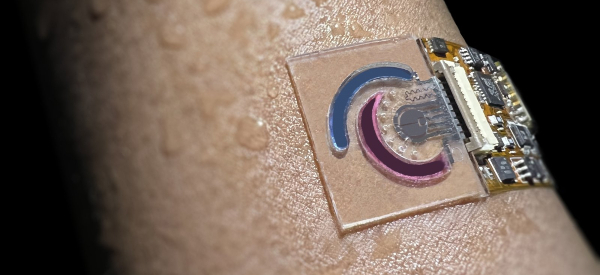Life Sciences
Sensor Unlocks the Secrets of Sweat
Is there any limit to the biodata attainable from sweat? Apparently not, at least that’s the implication from Caltech’s Cherng Department of Medical…


Is there any limit to the biodata attainable from sweat? Apparently not, at least that’s the implication from Caltech’s Cherng Department of Medical Engineering. Led by assistant professor Wei Gao, the Caltech team published a report explaining their technology in Nature Biomedical Engineering. The Caltech sweat sensor’s ability to detect nutrients and biological compounds relies on molecularly imprinted polymers and microfluidics, according to Gao.
In previous work with sweat sensors, Gao employed enzymes embedded with antibodies to detect biological compounds. Antibodies are only good for one use, however, which limits their value in wearables. The new Caltech biosensor tech uses molecular imprinted polymers to create artificial, reusable antibodies. To detect a specific biologic molecule, the engineers form the polymer around a sample of the molecule and then remove the molecule, leaving a precisely shaped hole in the polymer. The team then combines the polymer with a material that loses electrons, or oxidizes, in contact with sweat when electrical voltage is applied. When a biomarker molecule “fill ins” the vacant area or hole in the polymer, the voltage gets weaker. The greater the presence of the specific biomarker, the lower the voltage, which allows designers to set precise thresholds. The sensors can also be cleared for re-use by an electrical current that destroys the trapped molecules.
Gao and his team use microfluidic design to create tiny channels to detect a specific biomaterial using very small samples of sweat. Microfluidics enable detection of multiple biomaterials with a relatively small wearable device. The wearable uses a minimal electrical current on human skin to stimulate the small amount of sweat required for monitoring.
So far, this technology can detect the nine essential amino acids, vitamins, hormones, and drugs, Gao says. The Caltech team has successfully tested the technology on humans. Next steps include larger human trials. There are many potential applications for Caltech’s molecular imprinted polymers with microfluid designs to detect a wide variety of human health conditions. In future when we go for a medical checkup, perhaps an attendant will ask us to put on a multi-sensory wearable and read a magazine for five minutes while the device detects and analyzes our system.

Wittiest stocks:: Avalo Therapeutics Inc (NASDAQ:AVTX 0.00%), Nokia Corp ADR (NYSE:NOK 0.90%)
There are two main reasons why moving averages are useful in forex trading: moving averages help traders define trend recognize changes in trend. Now well…
Spellbinding stocks: LumiraDx Limited (NASDAQ:LMDX 4.62%), Transocean Ltd (NYSE:RIG -2.67%)
There are two main reasons why moving averages are useful in forex trading: moving averages help traders define trend recognize changes in trend. Now well…
Asian Fund for Cancer Research announces Degron Therapeutics as the 2023 BRACE Award Venture Competition Winner
The Asian Fund for Cancer Research (AFCR) is pleased to announce that Degron Therapeutics was selected as the winner of the 2023 BRACE Award Venture Competition….














